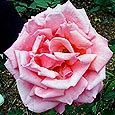

My Rose Page An experiment to determine tea rose with the sweetest, strongest fragrance as well as tests of various growing techniques.
(Click
here to browse 70 topics on my main
site ranging from exotic kaleidoscope designs to the strange world of
lucid dreaming.)
If you were
expecting a web page about roses written by an expert rosarian, I
regret to inform you that you've come to the wrong place. The sad
fact is that I'm brand new to roses. What this page contains is a
record of my fumbling attempts to grow these great plants. All my
mistakes will be laid bare for everyone to see in the hope that this
will help others avoid them. What I plan to do is use this page is to
record all the growing techniques I use coupled with how well they
work and the results of several growth experiments. This will allow
others to compare my plant's growth and flower productivity to their
own and in so doing develop improved culturing protocols. So, with no
further preamble, let's get started.
Depending on
what area you live in some of the planting and pruning dates on this
page may sound odd. The reason is that I live in the high desert
region of southern California. This area doesn't get its first frost
until the end of November and winters are usually very clear and
bright with daytime highs around 60. The humidity is very low.
Please scroll down to read all the articles or use the following bookmarks to jump to specific articles.
Which
roses to plant?
My
planting technique
Monthly
and weekly care schedule
March
2004 Update
April
2004 Update
May
2004 update
Blunders
Pictures
and evaluations of my roses NEW!! Comparing
two roses in cold weather
Experiments
with roses Final
Fragrance comparison complete!!!
The area available in my backyard for planting roses can hold only 40 plants. This limitation forced me to confine my efforts to a small sampling of the rose world. I decided to focus on hybrid tea roses with outstanding fragrance. nternet searches informed me that the most fragrant teas are considered those that have won the James Alexander Gamble Fragrance Award. This award is so difficult to win that it has only been bestowed ten times over the last 43 years as of the date of my page. I was able to obtain nine of the ten and to these added four more: Perfume Delight and Mister Lincoln (I found many rave reviews about their fragrance), First Prize and Peace (These last two were added because a rose garden hardly seems a rose garden without them.)
Here are the
roses I selected:
JAGFA = James
Alexander Gamble Fragrance Award
ARS = American
Rose Society rating
AARS = All
American Rose Selection winner
Crimson Glory...........released 1935, JAGFA 1961, .ARS=6.8
Peace.....................released 1945, -------------ARS=8.6, AARS Gold Medal
Sutter's Gold............released 1950, JAGFA 1966, ARS=8.0, AARS Gold Medal
Chrysler Imperial.......released 1952, JAGFA 1965, ARS=7.5, AARS
Tiffany....................released 1954, JAGFA 1962, ARS=8.3, AARS
Granada..................released 1963, JAGFA 1968, . ARS=7.7, AARS
Papa Meilland...........released 1963, JAGFA 1974, . ARS=7.3
Mister Lincoln...........released 1964, ------------. ARS=8.8, AARS
Fragrant Cloud..........released 1967, JAGFA 1970, . ARS=8.1
First Prize................released 1970, ------------. ARS=8.6, AARS
Perfume Delight........released 1973, ------------- ARS=7.5
Double Delight..........released 1977, JAGFA 1986, .ARS=8.7, AARS Gold Medal
Secret....................released 1992, JAGFA ????, .. ARS=7.7, AARS
None of the
sites containing Gamble Award information were current enough to show
recent winners. Secret is the latest winner as indicated in the
Spring 2004 Dutch Gardens Rose catalog, but not confirmed on any
JAGFA site I've been visited.
Fragrant Hour (released 1973, JAGFA 1997) is no longer available, at least not on any of the several dozen sites and rose indexes I've visited, so I won't be able to plant it. However, I found a specimen in Descanso Gardens in southern California.

The rose was five inches across and pink. The fragrance was sweet and strong even on a cool overcast morning. It's a pity this variety is no longer available.
As of January, 2004, I have one each of Sutter's Gold, First Prize, Peace and Crimson Glory. I have two each of all the others except Secret, of which I only have one plant. Lastly, I purchased one Veteran's Honor in a 5-gallon pot not for its fragrance but because it had the most beaustiful pure red blooms I've ever seen.
Once these roses are producing flowers, I intend comparing them to determine the overall winner in terms of quality of fragrance, strength of fragrance, flower appearance, and flower production. Nine more plants of this final variety, or varieties if there is a tie, will fill in the remainer of the garden and be used to replace any varieties that don't have enough interest to warrant retention.
Buying
roses
The first step in planting a rose garden is to select the best available plants. Bare root roses show up on the shelves of major home improvement stores the day after Christmas in my location. Wal Mart and similar stores have them available shortly after that. I quickly discovered that it's important to purchase roses within the first few days they are available. This insures that you can pick through all the plants of a given variety and select the ones that look the strongest and healthiest. Plants should look green and succulent. Avoid any with odd growths or bulges where the branches or canes grow out of the trunk. These plants are probably infected with crown gall. (One of my Secret roses had this and I failed to see it until planting time.)
Thinking that the main brand name roses (Armstrong, Jackson Perkins) with their larger tops and bulkier wrappings around the roots would be the best, I purchased those first and only resorted to the smaller, off-brand roses as a last resort. When I unwrapped them I was in for a shock.
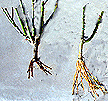
The picture above shows an Armstrong Chrysler Imperial rose on the left and a smaller off-brand rose on the right. While the top of the left plant looks impressive, the roots had all but been stripped away by the mechanized harvesting process used. On the other hand, the root system on the inexpensive off brand rose on the right was many times larger and appeared to be more alive. Most of the large, grade 1 big name roses I bought in December of 2003 had very weak root systems. The opposite was true for the smaller, cheaper plants. What this told me is that you can't tell the roots by the size of the plant or packaging, which is disappointing. It'll be interesting to see if there is any difference in how the plants develop as the season progresses.
I couldn't find three roses locally so I was forced to pay top dollar for mail order roses. At 17 dollars each these were twice as expensive as the name brand roses and over three times the price of the off brands. My main concern was that I had no control over the plants I got and might get stuck with poor samples. As the picture of one of them below shows, my concerns turned out to be unfounded.

The plants's tops appeared healthy and the root systems were the densest of any I'd come across. They came from Regan Nurseries. This particular plant is a Granada.
My techniques for planting and caring for roses is based on information picked up from many websites maintained by well known experts, such as Kitty Belendez of the Santa Clarita Valley Rose Society in California, several books on rose care, a little general plant care knowledge I have from many years of vegetable gardening and a desire to use fertilizers available from local stores.
The first planting step was immediately to open them up and soak them overnight in water to which 1 tablespoon of vitamin B-1 and 1 tablespoon of bleach had been added per gallon. The B-1 helps promote growth and the bleach helps kill off any diseases or pests lingering on the surface of the plants. I fill the soaking tub first then add the B-1 and Bleach. If I add the chemicals before the water, they react to form a brown mud. I don't know if this neutralizes them, But I prefer not to take the risk that it does.
The next step is to mix up a soil amendment to help get the plants off to a good start.
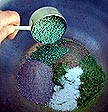
For each rose I used:
1/4 cup of
kelp meal
1/2 cup of
bone meal
1/4 cup of
10-10-10 Miracle grow Shake and Feed Slow Release fertilizer
1 tablespoon
Epsom Salt
1/2 cup of
Ironite (I run it through a small spice grinder or coffee mill to
convert it to a quicker-acting powder)
1 cup of
alfalfa meal (6 dollars for 30 pounds at a local feed store. Pelleted
alfalfa is easier to use but more expensive and it's hard to find
without added molasses and salt.)
After blending
this mixture, I add one third of it to the bottom of the hole and
work it into the soil. The rest I mix with the dirt removed from the
planting hole.
To make sure the roots are completely covered with dirt, I first form the dirt in the hole into a tall cone and spread the crown of roots over it.
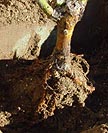
Then I backfill using the amended soil and pack the dirt down tight. Any remaining dirt is used to create a watering basin, which I fill twice to insure the plant is thoroughly watered.
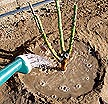
That's it! Working at a leisurely pace it takes two hours to plant 12 bare root roses.
The following program has not been optimized. It's just a collection of suggestions from many sources modified to fit my schedule and the local availability of products. It's certain to change as I gain experience.
From February through the end of October I work the plants every Saturday with the following procedure:
First
Saturday:
1. Spray all plant surfaces with 2 tablespoons per gallon of water of Orthenex Garden Insect and Disease Control. This is both a contact and systemic insecticide/mitecide/fungicide.
2. Feed each plant 1/4 cup Miracle Gro Shake 'N Feed Slow Release 10-10-10 granular plant food.
3. Feed each plant 2 tablespoons 5-1-1 fish fertilizer.
4. Feed each plant 1/8 cup Ironite.
5. Feed each plant 1/8 cup kelp meal
6. Feed each plant 1 tablespoon Epsom Salt.
7. Feed each plant 1/8 cup of blood meal.
8. Feed each plant ¼ cup alfalfa meal.
Scooping this mixture out of many different shaped packages was a hassle so I poured each fertilizer into a plastic bin with the contents labeled on the lid.

It helped keep everything neater and made scooping and mixing much easier. I also keep a laminated feeding schedule handy so I don't have to struggle to remember how much of each fertilizer is required.
I measure the weekly portion of fertilizer for each plant into a bowl so that each rose gets it's full share of nutrients.

If I mixed it all up in one large batch and then scooped out a portion for each plant there would be the potential that due to incomplete mixing some plants would be shorted.
The contents of each bowl is then worked into the top few inches of the 3 x 3 foot watering basin at the base of each plant then soaked it in.
Second
Saturday:
1. Spray the tops and bottoms of all plant surfaces with 2 tablespoons of Miracle Gro 10-52-10 soluble fertilizer and 1/2 teaspoon of Response liquid kelp per gallon of water.
2. For each rose, mix one-half teaspoon of Superthrive and two tablespoons of Miracle Gro 10-52-10 soluble fertilizer into one cup of water and spread this around the base of the plant. Water it in thoroughly. (Actually what I do is mix a large batch of this up all at once and measure out a cup per plant. I don't like using metering devices because I had one once that did not a provide uniform mixture as the concentrate was used up.) Note: I'm not a fan of Superthrive. There is too little evidence that it does any good.
Third
Saturday:
1. Mix in 1/2 teaspoon of Response liquid kelp per gallon of water and spray all plant surfaces.
2. Feed each plant two tablespoons of 5-1-1 fish fertilizer and one-half teaspoon Superthrive using the concentrated mixture technique mentioned above. Water it in thoroughly.
Fourth
Saturday:
1. Spray the tops and bottoms of all plant surfaces with 2 tablespoons of Miracle Gro 10-52-10 soluble fertilizer and 1/2 teaspoon of Response liquid kelp per gallon of water.
2. For each rose, mix one-half teaspoon of Superthrive and two tablespoons of Miracle Gro 10-52-10 soluble fertilizer into one cup of water and spread this around the base of the plant. Water it in thoroughly.
Seasonal
care:
Disbud and deadhead continually.
February: Fingerprune new shots to reduce locations where multiple shoots are emerging from one spot to a single shoot. Also fingerprune to remove poorly spaced or directed shoots.
August: Remove twiggy weak growth and cut back main canes one-third to encourage dense flowering in October.
September: Fingerprune new shoots.
December: Once plants are dormant, hard prune and clean plants of leaves and sweep ground. Conduct a soil PH test to determine if amendment is required. Shoot for a PH of 6.5.
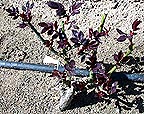

As the two pictures above taken on 5 March indicate, there isn't much to report for March. The Perfume Delight on the left was planted last Fall and as expected, is a few weeks ahead of the bare root Papa Meiland on the right, which was planted on December 26.
Of the bare root roses planted earlier this year, all of the long-rooted plants from Regan nurseries have strong, healthy sprouts. Half of the off-brand roses that had so-so root systems have also started showing sprouts. So far none of the Armstrong roses (good looking tops but no roots hardly at all) have yet to show a single sprout. In fact they look dead. If there was a problem with my planting technique and care, I would have expected that some of all the brands would have failed. Since this was not the case, I'm tending to think that the fault lays with the manufactures who cut away too much of the roots before packing. (Note: Prior to planting, I severely pruned back all of the top growth in the roses to reduce the stress on the roots.) I will keep the dead-looking bare root roses until the end of April. If they haven't shown any growth by then, I'll pull them out and replace them with pot-grown roses of the same varieties.
By 19 March all of the rose bushes were well into leafing out.


The two pictures above show the different between a container rose planted in the Fall (left) and the most advanced bare root rose planted December 26 (right). As expected, the container rose is one to two months ahead of the bare root plant.
The first bud appeared on 15 March on a Double Delight planted last Fall.

By 19 March there were half a dozen buds on this plant. None of the other plants had any, which suggests that Double Delight is one of the earliest bloomers. This isn't surprizing since it is also supposed to be one of the fastest repeat bloomers. This bud opened on 6 April: white petals edged in glowing pink/red with the inner bases of the petals brushed with yellow. Left in the sun, the red continues to spread inward so that as the rose opens it turns almost completely red. The petals are light and delicate looking. This is the first flower of the season and is small, as pictured below it is only four inches in diameter.

The fragrance is strong and sweet with a slight spiciness. This is the flower that got me started in growing roses. As much as I like it I'm frustrated by the variability of the flower colors.

Both of the flowers in the photo above were cut from the same plant on the same day. I'm assuming that the amount of red is determined from the amount of sunlight a particular bud receives. To test this theory, I kept one of the following two flowers in complete shade the entire time it was developing. The results are shown in the two following pictures:
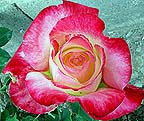
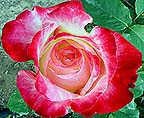
The rose on the left was kept in dark shade from the time the bud was 1/2 inch across until it opened. There really isn't enough difference between it and the rose on the right, which received full sun from early morning till 1 PM everyday. The days were clear and sunny during the entire period of this test. The red in the full-sun rose is slightly darker than the shaded rose, but not enough to justify the effort.
May 2004 update
By May all of the plants were producing flowers. The bare root roses planted back in December are still lagging behind the potted plants planted in Fall. I've noticed that the two-
gallon potted roses planted last Fall are larger and more productive than three large top-of-the-line plants purchased in April in 5 gallon pots.
The bare root roses planted in December average 18 inches tall. The 2-gallon potted roses planted last Fall average 30 inches tall.
The roses that have disappointed me are Sutter's Gold (flowers too small, barely single, tend to produce in clusters, weak fragrance), Secret (very attractive in the bud stage but they quickly open flat and fade very fast), Granada (a coarse looking flower with weak fragrance), Double Delight (weak stems, flowers that turn an unattractive red on the bush, and many buds that appear malformed because of the heat), and Peace (weak fragrance and the flowers don't take the heat very well.) The real winners are Mr. Lincoln (great color, fragrance, large flowers, and strong stems) and Fragrant Cloud (incredibly fragrant, large round flowers that look good from any angle, eye-catching color, strong stems and best off all the flowers last up to two weeks on the plants.)
New Rose Tool! I've been experimenting with several different scrapers to use to mix dry fertilizer into the dirt around the base of my roses. None of them worked very well. Then I good an idea that did. I purchased a hefty three-pronged garden fork from Wal-Mart and used a hack saw to cut the outside two prongs off. It left me with a single pronged tool that is easy to use around the base of the roses.

I'm sure someone makes something like this but I haven't seen it in my area.
February 2005 update: time to finger prune.
Its early February and in my high desert location that means the rose bushes are starting to sprout. This is your first chance to control the shape of the bush so that you get the type of plant you want by finger pruning the shoots.

Consider the picture above. It shows an all to common problem: three or more shoots sprouting from the same location. Left on their own, they would tend to produce three small canes. I prefer to knock off the small outer shoots to encourage the large center shoot to grow to a large, stronge cane. I also remove shoots that will tangle in other shoots as the grow, shoots that are aimed at existing canes from last year's growth and too many shoots sprouting from a thin cane.
NEW!!! An 87-cent dethorning tool!
The best way to get rid of thorns is to use a slight side pressure to push them off the stem while the cane is young, long before the rose blooms. At this stage the thorns are soft and pop off with little effort. The scar where the thorn was will have time to heel to form a smoother cane when cutting time comes. The second best way to remove thorns is to do the same thing when the rose is cut.
The problem with both techniques is that on some roses, like Perfume Delight, the thorns grow so close together that it's many times impossible to push one off without getting stabbed by a hundred others. Even for roses with few thorns, like Chrysler Imperial, it can take considerable time to remove all the thorns. Fortunately, there's a quick and easy solution: a dethorning tool.
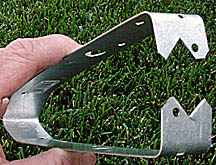
The one above was made from a piece of light weight strapping from a hardware store. It was 1 and 1/2 inches wide, 18 inches long, and only cost 87 cents. I used tin snips to cut a "V" into both ends and bent the strap as you see. Running a file over the edges of the jaws will round them off so that they don't tear up the sides of the stem to badly.
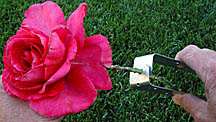
To use it just hold the rose close the the flower, close the jaws very lightly around the stem and drag the thorn remover down. Off come the thorns.
This thorn remover also works while the rose is still on the plant. Just pull up from where you plan on cutting the stem. The thorns actually come off cleaner this way.
It's important to avoid using too much pressure when closing the jaws or they will abrade the surface of the stem. For this reason this tool might not be something you want to use on a rose intended for a show.
This is where I will confess to the mistakes I make in the hopes that it will help visitors avoid them.
Planting Canterbury Bells between my rose plants. It seemed like a good idea at the time: the bells would bloom and provide a burst of Spring color while the roses were getting up to speed. The problem is that I didn't know that Canterbury Bells can grow to be 4 feet high and thread themselves almost vine-like up through the roses almost strangling them. I'd estimate that I've lost at least a month's growth off the roses and some have been damaged by the Canterbury Bells growing up through them then falling over. From now on it's strictly bare ground under my roses.
Failing to cover the canes with a mound of mulch. After my first planting of bare root roses had been in the ground three weeks, I noticed that almost all of them showed minor wrinkling on the surface of the canes. I assume this is from the canes drying out. A mound of leaves or some other mulch might have helped the plants retain their moister. Only time will tell how many of the plants live.
Spraying the plants with Superthrive. Superthrive, the plant growth stimulate, is recommended by many rose growers so I thought I'd give it a try. While watering it in one day I thought, "Why not sprinkle the leaves as well for a little foliar boost?" So I did. My blunder was in forgetting that Superthrive smells like your worst nightmares of liquid cold medicine. Some of it got into the open flowers and made them smell terrible. From now on I'm making sure superthrive only goes on the roots.
Being
clumbsy when
mixing fertilizer around the base of the roses.
On the first of every month I mix a cocktail of fertilizers and soil
amendments into the soil at the base of each plant. The problem is
that I tend to get too aggressive about digging it in and in so doing
brush against new shoots that have sprouted from the plant's crown.
These tend to become the main canes for next year and produce the
largest flowers. When young the point where they attach to the plant
is extremely delicate and the slightest nudge can break them off.
This last month I lost three by not being careful.
Failing to use a bottle brush on cutting vases. For the first two months of cutting roses, I got into the bad habit of just rinsing the vases out between uses. After a while I noticed that the cut flowers seemed to be wilting faster. It turns out that by not using a bottle brush on the vases I was leaving a scummy residue of bacteria behind. Then when the vases was used again this bacteria quickly bloomed and attacked the cutting. Now I scrub each vase out between uses and the roses appear to last longer.
Pictures
and evaluations of
my roses:
These aren't show-quality flowers and I'm not a professional photography, but I'm posting pictures of them anyway because even an average rose is still nice to look at.
Mister Lincoln:
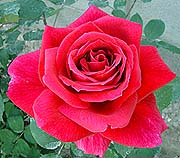
It's hard to do much better than Mr. Lincoln: great red color, almost perfect form and a outstanding fragrance. My only complaint is that older petals fade to pink. I prefer the sweeter fragrance of Chrysler Imperial because in comparison, Mr. Lincoln has a slightly edgy or grassy note.
Chrysler Imperial:
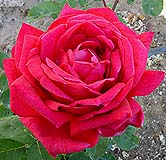
In my warm, dry, high desert location it is sometimes difficult to tell the difference between Mr. Lincoln and Chrysler Imperial. Chrysler Imperial is usually pinker, has more petals, thinner petals, slightly smaller flowers and a sweeter fragrance that's stronger than Mister Lincoln at indoor temperatures. It's going to be tough for me to decide which I prefer but since fragrance is my main criterion I'm leaning toward Chrysler Imperial.
NEW!!! When the average Fall temperature dropped below 70 degrees I noticed that the buds stopped opening properly. They tended to ball up with only the top edges of the petals curing outward. The fragrance seemed to weaken as well. I suspect because the petals were so tightly balled that it couldn't escape.
Double
Delight:
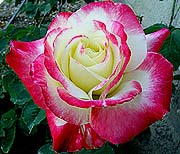
Double Delight is a great looking and smelling rose. One problem I've noticed as that three days after bringing a cut flower inside, the perfume changes from sweet to something closer to sour dish water. I haven't noticed this in any other roses. In my garden Chrysler Imperial and Mr. Lincoln have sweeter fragrances than Double Delight.
The picture above shows a Double Delight at it's best. Most mature flowers in my high desert area end up looking mostly coarse red. I've also noted that very bright sunlight and high temperatures sometimes cause the buds the deform, producing flowers with small twisted petals.
Fragrant Cloud:
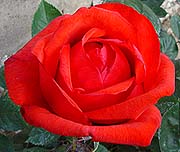
One of the strongest-scented tea roses. The flowers are the longest lasting of any in my garden and open to large dense spheres of color that are attractive from any angle. So far it's also dealing with the heat better than any of the other roses, keeping good shape, size, and color. Cut Fragrant Clouds give off more fragrance at the cool temperatures of most houses than any other tea rose.
Peace:
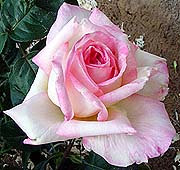
This is a poor example of one of the most popular roses of all time. These always remind me of lace for some reason. In my high desert location the bright sun bleaches most of the pink out of the flowers. The petals are thin and many of the flowers end up looking like unattractive bundles of crepe paper.
First
Prize:
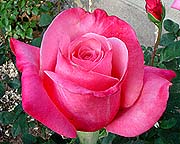
One of the most decorated of all roses. Huge size, wonderful color, very thick petals and it even has some fragrance. But, in my area the pink isn't clean but has an unattractive streaky look.
Granada:
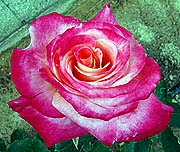
I find Granada to be similar to Double Delight in that the petal edges are red, the middles are white and the centers yellow. The flowers are smaller than Double Delight, the colors not as pure and the fragrance is much weaker. The overall impression is that it isn't as refined as Double Delight, which, by the way, is an offspring of Granada.
Crimson
Glory:
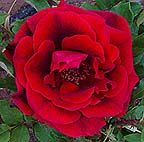
A good rose in it's day (1935,) but more modern roses like Mr. Lincoln, Chysler Imperial and Veteran's Honor have better color, form and fragrance.
Secret:
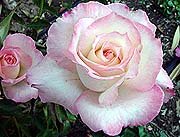
A very refined form, beautiful coloring and superb fragrance make this a good rose. My complaints are that in hot, sunny weather most of the pink bleaches out and the petal count is too low, the flower opens flat.
Sutter's Gold:
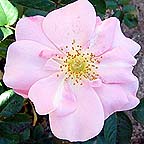
A light pink, small, barely double rose with a weak fragrance when compared to the other roses on this page. A big drawback is that the flowers are produced in clusters instead of individually. This means a lot of disbudding to encourage the main flowers to grow as large as possible.
Veteran's Honor:
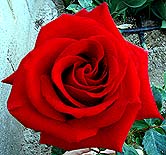
Veteran's Honor has the purest red I've every seen in a rose. There is absolutely no trace of orange, pink or black that weakens so many other red roses. The petals look like the richest velvet. The fragance isn't strong but this flower caught my eye in the nursery and I couldn't resist it.
Perfume Delight:
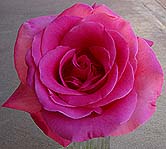
This is a great flower. The pink is pure, the size large, the fragrance strong and very sweet. Right now it's a dead heat between Perfume Delight and Chrysler Imperial for the number one spot in my garden.
NEW!!! Unlike Chrysler Imperial, Perfume Delight's buds continued to open in perfect form in cooler weather. The flowers seemed to last forever on the plant and the fragrance was noticeably stronger than Chrysler Imperial, probably because more petal area was exposed to release the fragrance.
Papa Meilland:
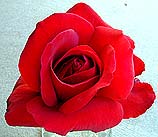
A pure red rose with a very sweet fragrance, but the strength of the fragrance is not as great as Perfume Delight, Chrysler Imperial, Fragrant Cloud, Mr. Lincoln or Double Delight.
Tiffany:
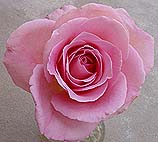
A very attractive rose with pure pink petals touched with yellow at the base. The fragrance is pleasant, but not as strong as Chrysler Imperial, Mr. Lincoln, Perfume Delight, Fragrant Cloud, or Double Delight. These flowers have a very refined, elegant look to them.
NEW!!!
Once the weather turned cold,
Tiffany's buds open extremely slowly. However, their form and color
remained absolutely perfect and were still very attractive.
NEW ROSE!!! Henry Fonda:
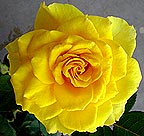
A deep, rich, pure yellow rose with a strong spicy fragrance. The flower size appears to be slightly smaller than many tea roses but otherwise this is a real winner. As the flowers age and eventually fade, they get pale pink spots all over the petals. This isn't a big problem because by the time this happens the roses are so far gone that most people would have already pruned them off the bush.
NEW ROSE!!! Oregold:
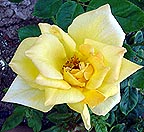
In my high desert location the petal count was too low, the color too light and there was too little fragrance.
NEW ROSE!!! Apollo:
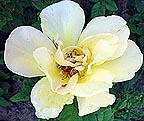
The same comments for Oregold apply to Apollo, except its color was even weaker, almost white.
The following series of articles is set up in a question-and-answer format. As I think of a question about roses I will conduct an experiment to answer it.
Which
organic sprays work best for getting rid of aphids?
Insecticidal soaps, such as the one sold by Safer, are an excellent organic way to kill aphids. Used repeatedly they also help repell aphids.
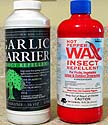
Two other options are Garlic sprays and hot pepper sprays, pictured above. I tried the garlic spray and it didn't seen to do much good. After two sprayings three days apart, the number of aphids on my roses appeared to be the same.
The hot pepper spray was much better. After one aplication the aphid population dropped dramatically. Oddly enough, the pepper spray doesn't smell peppery. If anything it has a slight minty aroma.
When
starting a new rose bed, is it better to plant potted roses in
late summer or early Fall
or wait until spring and plant bare root roses?
To answer this I planted half of the 21 roses for the 2004 season in October using the best potted roses available in the varieties I wanted. Because this was the end of the year the plants had been pretty well picked over and the quality of the remaining plants was poor. Between planting time and the first frost, which hit around November 20, the plants grew slowly and only produced a few flowers. By 10 December they had gone dormant.
Bare root roses start showing up in my area the day after Christmas. I hit the stores early and picked through the offerings to select the plants with the healthiest top growth, ideally with at least three thick canes. Because I had specific varieties to look for, some of which were not common, I couldn't always obtain the quality I wanted. I took the best of what was available home and planted them immediately using the procedure explained above.
Results: Plant potted roses in Fall or wait until they are available in Spring instead of planting bare root roses. Many of the bare root roses I planted never sprouted, I believe because too much of the roots had been cut off. Even though I pruned the tops back by half or more, the plants still didn't have enough root mass to support them.
Which is more important in bare root roses: quality of top growth or roots?
While selecting my bare root roses I chose those with the strongest top growth thinking that they would also have the strongest root system. I was wrong. The photo below shows what I discovered after unwrapping two bare root roses.

The one on the left was by Armstrong and had a top that looked like a million dollars. The only problem was that it literally had no roots, just a few short stubs. On the other hand the rose on the right had a spindly top, common for cheap one-year plants. It was a bulk buy by Home Depot and didn't even have a brand name. However, when I opened it up I discovered it had a healthy and dense root system.
I read in one rose book that the preferred method of selecting bare root roses is to go to a nursery where they are stored in large tubs filled with damp sawdust so that you can see what the roots look like. Regrettably, I don't know of any nurseries that sell roses like this.
Most of the bare root plants I opened in 2003-2004 followed the pattern of the smaller, cheaper one-year plants having better root systems than the larger name brand roses.
I will monitor the growth of the large and small rooted plants to determine if the smaller plant with the better root system ends up beating the larger plant with the poorer root system.
Result: The quality of the roots is far more important that the top growth. Without a good root system the bare root plants may never even sprout, as was the case with all but one of the roses that had small root systems.
Can
you use stem cuttings from grocery store roses to propagate new plants?
In a fit of romantic frenzy I purchased a dozen pink roses from a local Albertsons grocery store for my wife. They were attractive and unlike many cut roses had a pleasant fragrance.
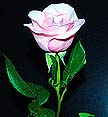
After trimming the bottoms of the stems, I made second cuttings four inches long, dipped the bottom halves in rooting powder and potted them in a large soup cup filled with dampened, not wet, potting soil.
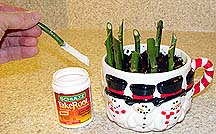
After a month I pulled the cuttings out but none had produced roots. I conclude from this that the lower parts of the stems of cut roses are to old to be coerced into rooting.
Can
a beat-up potted rose be saved?
I found a pitifully mistreated Perfume Delight late in October of 2003. It was laying on its side in a broken pot filled with dried-out soil. The plant only had a few thin stems and its trunk looked like it had been through a battle.
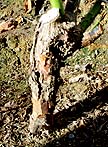
But, there was a hint of green in one skinny branch so I decided to attempt a resurrection. First thing I did was give the pot a thorough soaking. Then I pruned off all of the top growth except the one stem that still had a bit of green to it. After planting it following the planting technique mentioned above as closely as possible I sat back and waited.
Unbelievably, after two weeks shoots started appearing.
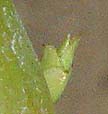
Four weeks after that the plant had a few thin stems with leaves.
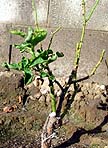
After another month the plant rewarded my efforts on its behalf by producing a flower.
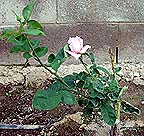
What this taught me is that roses are tough plants that cling to life with admirable tenacity.
Result: Maybe, but it's a gamble. In the case of the rose above, it just started to sprout in Spring then died.
Are
expensive mail order bare root plants better than local store bought
bare root roses?


The expensive ($16) mail order rose on the far right certainly looks better than eight the Armstrong ($8) on the left or the off brand ($4) in the middle, but only time will tell how much better it grows. I should have the answer to this question by May of 2004.
Result: Yes, the expensive plants with the better roots systems are better. They are more likely to live and sprout earlier and stronger than the cheap plants ourchased in store. But, I'd say that they are only 50 percent better, which does not balance with the fact that they can cost three times as much.
Does Perfume Delight, Mister Lincoln, or one of the nine JAGFA winning roses have the sweetest and strongest fragrance?
Fragrance comparison complete!!!
This
is it! This is the reason I started growing roses: to discover which
hybrid tea had the sweetest and strongest frangrance. I compared nine
of the ten James Alexander Gamble Fragrance award winning roses and
two others, Mr. Lincoln and and Perfune Delight, on two different
occasions at room temperature and the winner was...
Chrysler
Imperial! It was a clear winner in both strength of fragrance and
sweetness of aroma. Here's how the other roses faired:
1. Chrysler Imperial (strongest and the clearest, sweetest fragance)
2. Perfume Delight (almost as strong but the aroma had a very slight grassy edge to it)
3. Fragrant Cloud (Slightly weaker than Perfume delight. Sweet, but with a harsh note.)
4. Mister Lincoln
5. Double Delight
6-11 (All the others had fragrances that were so weak compared to the top five that they were hardly noticeable.)
All roses were compared side by side at the same stage of openness and at the same temperature.
I also compared the above the the one JAGFA winner I couldn't get, Fragrant Hour, by memory to the ones above and would guess that it would type with Mister Lincoln for the number four position: Fragrant Hour wasn't quite as strong but it was sweeter.
So, what am I going to do with this information? I replaced many of the least attractive roses with little fragrance with Chysler Imperials and Perfume Delights. As of 24 May, 2004 I have:
13 Perfume Delight roses
13 Chrysler Imperials
3 Fragrant Clouds
2 Tiffanys
1 Secret
1 Veteran's Honor
1 Mister Lincoln
1 Apollo (yellow)
1 Oregold (yellow)
1 Golden Masterpiece (yellow)
For
a total of 37 bushes, a modest little backyard rose garden but I'm
hoping it'll be productive.
Do
older rose plants bloom earlier in Spring than young plants?
Result: No. Comparing my two year old plants put into the ground in Fall of 2003 to my neighbor's plants that are huge and at least 16 years old, I found that they all start flowering in Spring at the same time.
Do Baking Soda sprays cure powdery mildew?
Result: It did in my garden. I mixed 3 tablespoons of baking soda in a gallon of water and sprayed all my bushes, one quarter of which were infected with powdery mildew, twice a week. After one week all traces of powdery mildew was gone.
The bad news was that I think I used too much baking soda because the leaves on a few bushes look burnt.
I intend to start a preventative schedule of spraying of two tablespoons of baking soda per gallon of water and spray all the bushes once every other week.
Is it better to clean all the leaves off roses during the winter dormant season or leave them on?
My high desert location has mild winters with mostly sunny days. Roses stop growing and flowering, but the occasional night time frosts are not hard enough to kill the foliage. By leaving leaves on the canes the plants may continue to expand their root system over winter and may get a head start in spring over plants that have been cleaned of all foliage. I plan to compare the spring flowering dates of two identical rose bushes, one of which has been cleaned over winter and the other with the leaves left on, to see if there is any difference.
Result:
No. Leaving leaves on over winter does not enable the plants to
flower earlier. Many of my neighbors have roses they left unpruned
over winter. They are producing buds at the same time that my plants,
which were heavily pruned and had every leaf removed.
Return
to the my main page to browse 40 other subjects